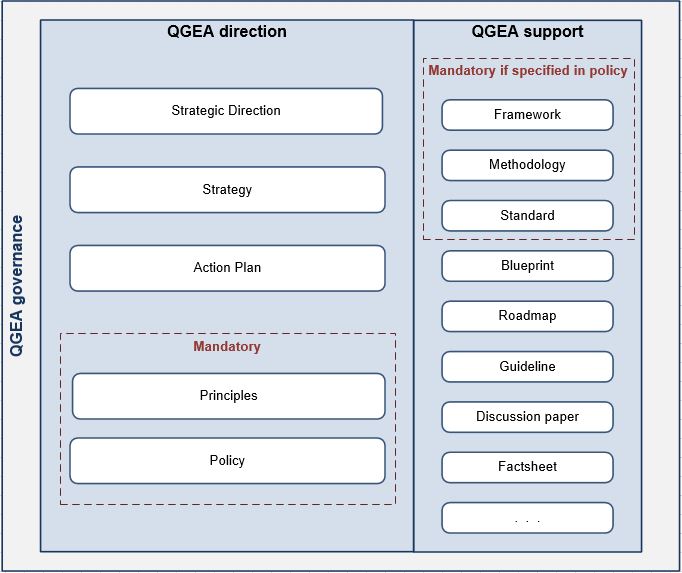QGEA self-assessment guideline
Alignment with the QGEA means having achieved or being on track to meet the policy and reporting requirements, or targets set within QGEA policy or principles documents.
The QGEA self-assessment workbook is a tool to assist agencies in assessing their alignment with the QGEA as part of ongoing business improvement, managing digital and ICT risks, guiding digital and ICT investments and supporting operational decision making.
The QGEA self-assessment does not need to be submitted to QGCDG.
Figure 1 depicts the hierarchical relationship of the major elements of the QGEA and shows the alignment process applied to requirements and targets. Note: some targets may be located within QGEA policies.

Assessment is conducted by selecting a response from a set list of values. The set list of values differs for policy requirements, principles and targets. Assessment of QGEA requirements is done in terms of compliance with requirements (either policy requirements or principles). Assessment of QGEA targets is done in terms of achievement of the target.
Table 1 lists the assessment values applicable to each of these mechanisms of the QGEA.
Document type | Assessment category | Assessment values |
|---|---|---|
QGEA policy or principle document | Mandatory principle and policy requirement (Assessed in terms of compliance with the requirement.) |
|
Implementation target (Assessed in terms of achievement of the target) |
|
Table 1 - Assessment values for mechanisms of the QGEA
Tables 2 and 3 below provide a description of each assessment value.
QGEA policy requirements | |
|---|---|
Fully compliant |
|
Substantially compliant |
|
Partially compliant |
|
Not compliant |
|
Exception granted |
|
Not applicable |
|
Table 2 - Description of values for mandatory principles and policy requirements
Implementation target | |
|---|---|
Achieved |
|
On track |
|
Not on track |
|
Not planned |
|
Exception granted |
|
Not applicable |
|
Table 3 - Description of values for Implementation targets
The self-assessment workbook comprises multiple tabs:
- Introduction.
- Overall summary this presents a rolled-up view of overall department compliance with the QGEA.
- Per-artefact summary this presents a rolled up, per-artefact summary of departments compliance with the QGEA.
- Policy statements this provides a complete set of all approved policy statements. There is no assessment for policy statements, but they are included for reference.
- Compliance requirements this tab includes all policy requirements, mandatory principles and targets. Departments must assess and select an assessment value for each applicable row on this tab.
- QGEA reporting requirements provides a list of other reporting requirements mandated by the QGEA.
- Reference this tab lists the allowable values used for completing the assessment.
The compliance requirements tab includes columns that detail each requirement. Auto filters are enabled on the columns to allow selection of subsets of the requirements for easier consideration.
- QGEA document - the name of the document which is hyperlinked to the QGEA document on the QGCIO website.
- Type - the type of the QGEA document; policy, information standard or position paper.
- Mechanism - the type of QGEA mechanism being assessed. There is a direct correlation with the type column. Policies include policy requirements, information standards include mandatory principles and positions, and some policies, include targets.
- # - the unique number of the compliance requirement. Where there are multiple compliance requirements within a QGEA document they are identified by a unique number.
- Target or requirement (mandatory principle) - this provides the text of the requirement as per the approved and published document.
- When - the date on which the compliance requirement is expected to be complied with or the target achieved.
- Assessment - this column is to be completed by the department. The assessment status row on the overall summary tab simply counts the values entered in this assessment column to determine if the assessment has been completed.
- Comments - departments may enter additional information in this column to support their assessment.
- Assigned to - departments may enter values into this column to aid with assigning portions of the self-assessment to separate areas within their department for completion.
- Remaining columns - the remainder of the columns contain formulas that assist in calculating the summaries of assessment status. Do not change any values in these columns.